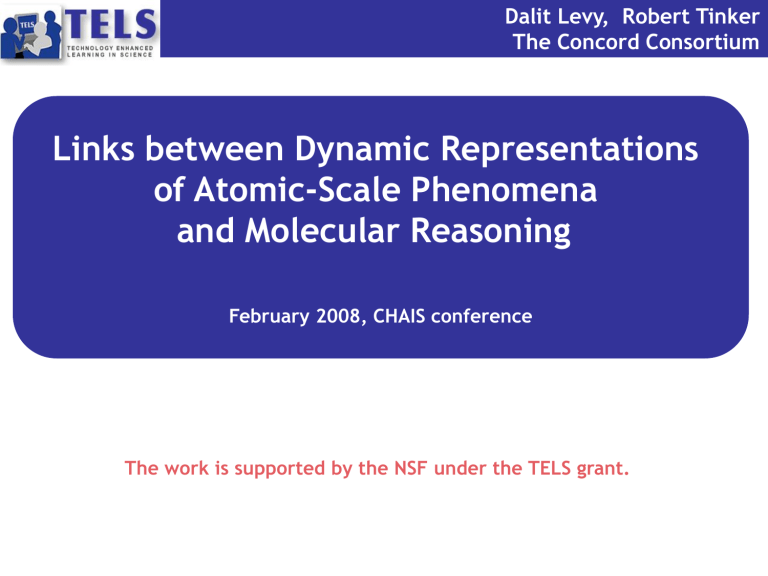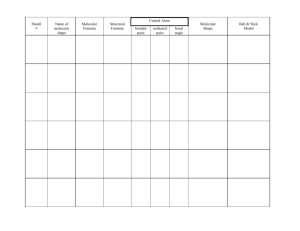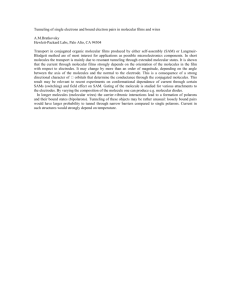
Dalit Levy, Robert Tinker
The Concord Consortium
Links between Dynamic Representations
of Atomic-Scale Phenomena
and Molecular Reasoning
February 2008, CHAIS conference
The work is supported by the NSF under the TELS grant.
Today’s Presentation Outline
1. The need for a TELS project on Phase Change
2. The goals of the project
3. Research goals and questions
4. Participants and data
5. The need for a Molecular Reasoning scale
6. Results of analyzing the data using the MR scale
1. Why did we design the
“Phases of Matter and Phase Change” Project?
Traditional instruction of phase change in high school
chemistry classes might leave too many students with a
little understanding of underlying concepts and processes.
For example, in TELS 2004 benchmark assessment:
• only half of the students knew that when phase change
In spite of prior knowledge that students have after dealing
occurs the temperature stays constant
(macroscopically) with states of matter in the elementary
• 42% of the students didn’t know that the temperature is a
and the middle school, many of them lack the ability to
measure of the average kinetic energy of the molecules
integrate the molecular (microscopic) aspect they are
exposed to in their high school chemistry lessons into an
elaborated conceptual account of processes of phase
change (Smith, Reiser, Anderson, & Krajcik, 2006).
2-a. The goals of the
“Phases of Matter and Phase Change” Project
Goal 1 - Knowledge Integration (KI)
Develop the learners’ ability to integrate knowledge
about macroscopic and molecular properties of the
three phases of matter
Goal 2 - Molecular Reasoning (MR)
Enable the creation of higher level explanations of
phase change related phenomena
Instructional Technology
The
Phase
Change
project
2-b. Static
vs. Dynamic
visualizations
Static Molecular Models
(From Pearson Prentice Hall Chemistry, 2005)
Static models only partially represent atomic-scale properties. The
static representation is just one specific frame of the ever-changing
dynamic molecular world. In spite of prior
Students have difficulties understanding that atoms are in constant
motion in solid, liquid and gas (Pallant & Tinker, 2004).
The
Phase
Change
project
2-c. Static
vs. Dynamic
visualizations
Dynamic Molecular Models
The TELS model of solid
The TELS model of liquid
The TELS model of Gas
Molecular Workbench models use a computing engine that lets users
observe and interact directly with a sophisticated representation of the
molecular world.
In TELS, these dynamic models are embedded within an inquiry activity
that enables the recording of predictions before, and reflections after, the
interaction with the models.
3. Research Goals and Questions
Research Goals
•Examine the level of molecular reasoning
in students explanations of phase change phenomena
•Trace the changes in students’ level of molecular reasoning
and their level of knowledge integration
Research Quaestion
What are the changes in the students ability to use
Molecular Reasoning (MR) in their explanations of
phase change phenomena?
4-a. Participants and Data
Participants
• 5 TELS high schools in MA, NC, WI
Examples of post-test
• 8 teachers (7responses
chemistry, 1 biology)
313 pairs
of students, grades
9-12adding heat the
Student #5: “hot •water.
EXPLANATION:
when
(diverse
background)
molecules tend to break
down
faster”.
Student #18: “hot water. EXPLANATION: The hot water will
break
the
intermolecular
forces faster than the cold water
Data
Sources
Sample
assessment
item
will.want
Which
will make
the
molecules
have
a lessmix
restricted
answers
to four
preandfast,
posttest
items,
designed
IfStudents’
you
something
to dissolve
you
should
it with: to
range
oflearners
motion”.ability to employ a molecular point of view
assess
the
(a) Hot water. (b) Cold water.
while explaining a familiar phenomenon.
Explain why, referring to molecular motion.
Overall, more than 2000 answers were examined.
Examples of pre-test responses
Student #10: “hot water. EXPLANATION: Sugar dissolves
faster in a cup of hot milk than in a cup of cold milk.”
Student #18: “hot water. EXPLANATION: the molecules move
faster”.
4-b. Participants and Data
Example - item 7 in the pre/post test:
What happens to water molecules when a cube of ice is taken
out of the freezer and left at room temperature?
173 pre: “The molecules are heated up, and begin to
move faster and the ice will melt because of the
increased speed of the water molecules”
173 post: “The water molecules begin to move faster,
31 pre: “The cube of ice will melt. The warm molecules
and break apart more, therefore a smaller intermolecular
in the air go to the ice and slowly mix with the cold
force, and it causes the ice to melt, and become water
molecules making the ice cube melt”.
again.”
5-a. The Molecular Reasoning Scoring Rubric
Student responses were coded using a new rubric, titled the
Molecular Reasoning scale
Score
3
Description
Dynamic molecular reasoning, including
correct description of the weakening of
intermolecular forces
2
Dynamic molecular reasoning (speaking
about molecular motion) OR understanding of
theHistorical
role of intermolecular
forces in melting the
Reference
ice
Pauling (1944 Nobel prize winner) “worked from
1
Static molecular reasoning: speaking about
crystallographic
data, and his bonds were static,
molecules, but not about their motion.
stable,
and enduring”.
Molecules
separate,
molecules break, and
Zewail (1999
Nobel
prize winner)
set those
also just
including
the term“has
"molecules"
in the
expl anation
bonds in motion,
making them as alive and dynamic
0
Nochemistry
molecular itself”
reasoning
as
(Smith,1999)
5-b. A scale for measuring Molecular Reasoning (MR)
Some MR scoring issues
98 pre: In a solid the intermolecular bonds are close, in a liquid
the intermolecular bonds are spread apart but don't move that fast.
In a gas the intermolecular are spread far apart and mover slow.
Dynamic image, scored 2.
176 pre: gas bonds are weak since the atoms are more
spread out then liquid, and liquid is a weaker bond then a solid
because solids are close together and used all together
Static image, but speaks of bonds - scored 2.
167 pre: The arrangenment of the balls determines
the phase of the matter, a tight arrangenment would
Indicate a solid matter.
Static image, scored 1.
Keywords
3
Bond +
2
Speeding
1
Expand
6-a. Results
Improved ability of Molecular Reasoning (MR)
The MR score improved from pre- to post for 76% of the students.
Changes in MR from pre to post
No gain
Negative gain
Positive gain
10%
14%
76%
The positive gain group started the learning with an
average MR score below the static MR level and finished
closer to a dynamic MR level. The other two groups were
already above the static level in the pre-test.
6-b. Results
Significant change from pre to post
Within the positive gain group, the average MR level improved
from 0.91 (pre) to 1.67 (post). The pairs of students in this group
(76% of the pairs) clearly climbed above the static level of molecular
reasoning, employing a more dynamic point of view after learning
with the TELS project.
Average Pre-test MR score
Average Post-test MR score
1.8
1.6
1.4
1.2
1
0.8
0.6
0.4
0.2
0
All
Positive
gain
No gain
Negative
gain
6-c. Results
Distributions of MR scores in the positive gain group
Only 3 pairs showed a dynamic MR in the pre-test, and no pair
expressed the highest intermolecular level. Students start the TELS
Phase Change project with a little prior knowledge about
molecular dynamic, and without any knowledge about
intermolecular forces.
Post-test MR scores
Pre-test MR scores
35
35
33
32
27
28
22
18
21
19
20
19
16
15
17
15
13
12
10
10
10
7
5
0
27
25
25
20
29
30
30
3
0
0
.25
.50
.75
1
1.25
1.5 1.75
2
4
5
0
1
2
0 .25 .50 .75 1 1.25 1.5 1.75 2 2.25 2.5 2.75 3
In the post-test, 18% scored 2 or higher, presenting the highest level
of understanding.
6-d. Results
Qualitative Results
1. Pre-test responses tend to be a mix:
“the molecules melt” (mixing macroscopic and molecular aspects)
“the bonds separate” (mixing molecules and bonds).
2. Pre-test responses show a clear lack of knowledge about intermolecular
forces. When using the term, it is often very wrong.
3. When is a certain phase of matter stronger than the other?
Six categories were found:
Harder to break is stronger;
Stable is stronger;
Heavier is stronger;
Harder to separate is stronger.
Denser is stronger;
Faster is stronger;
The 3 left categories reflect non-MR; the 3 right categories reflect MR.
Thanks for listening!
1. The need for a TELS project on Phase Change
2. The goals of the project
3. Research goals and questions
4. Participants and data
5. The need for a Molecular Reasoning scale
6. Results of analyzing the data using the MR scale







